A Grain Yield Sensor for Yield Mapping with Local Rice Combine Harvester
Abstract
:1. Introduction
2. Materials and Methods
2.1. Experimental Setup and Field Preparation
2.2. Rice Grain Yield Mass Meter
2.3. Data Acquisition Module Design
2.4. Rice Grain Yield Flow Sensor Software Design
2.5. GNSS Receiver
2.6. Field Moisture Sensor
2.7. Data Junction Box
2.8. Field Computer
2.9. Geostatistical Analysis and Mapping
2.10. Field Test of the Developed Yield Meter
3. Results and Discussion
3.1. Performance of the Developed Yield Meter
3.2. Effect of Grain Flow Rate and Yield Auger’s Inclination on Performance of Yield Meter
3.3. Effect of Machine Setting on Performance of Yield Meter
3.4. Yield Range and Moisture Content Mapping
3.5. Rice Grain Flow Rate with Moisture Content in Plantation 1
3.6. Rice Grain Flow Rate with Moisture Content in Plantation 2
3.7. Rice Grain Flow Rate with Moisture Content in Plantation 3
4. Conclusions
Author Contributions
Funding
Institutional Review Board Statement
Informed Consent Statement
Data Availability Statement
Acknowledgments
Conflicts of Interest
References
- Campos, I.; González-Gómez, L.; Villodre, J.; Calera, M.; Campoy, J.; Jiménez, N.; Plaza, C.; Sánchez-Prieto, S.; Calera, A. Mapping within-field variability in wheat yield and biomass using remote sensing vegetation indices. Precis. Agric. 2019, 20, 214–236. [Google Scholar] [CrossRef]
- Esau, T.; Zaman, Q.; Groulx, D.; Farooque, A.; Schumann, A.; Chang, Y. Machine vision smart sprayer for spot-application of agrochemical in wild blueberry fields. Precis. Agric. 2018, 19, 770–788. [Google Scholar] [CrossRef]
- Grisso, R.D.; Jasa, P.J.; Schroeder, M.A.; Wilcox, J.C. Yield monitor accuracy: Successful farming magazine case study. Appl. Eng. Agric. 2002, 18, 147–151. [Google Scholar] [CrossRef]
- Koirala, A.; Walsh, K.B.; Wang, Z.; McCarthy, C. Deep learning for real-time fruit detection and orchard fruit load estimation: Benchmarking of ‘MangoYOLO’. Precis. Agric. 2019, 20, 1107–1135. [Google Scholar] [CrossRef]
- Moral, F.J.; Serrano, J.M. Using low-cost geophysical survey to map soil properties and delineate management zones on grazed permanent pastures. Precis. Agric. 2019, 20, 1000–1014. [Google Scholar] [CrossRef]
- Memic, E.; Graeff, S.; Claupein, W.; Batchelor, W.D. GIS-based spatial nitrogen management model for maize: Short- and long-term marginal net return maximizing nitrogen application rates. Precis. Agric. 2019, 20, 295–312. [Google Scholar] [CrossRef]
- Samseemoung, G.; Jayasuriya, H.P.W.; Soni, P. Oil palm pest infestation monitoring and evaluation by helicopter-mounted, low altitude remote sensing platform. J. Appl. Remote Sens. 2011, 5, 053540. [Google Scholar] [CrossRef]
- Samseemoung, G.; Soni, P.; Jayasuriya, H.P.W.; Salokhe, V.M. Application of low altitude remote sensing (LARS) platform for monitoring crop growth and weed infestation in a soybean plantation. Precis. Agric. 2012, 13, 611–627. [Google Scholar] [CrossRef]
- Samseemoung, G.; Soni, P.; Sirikun, C. Monitoring and Precision Spraying for Orchid Plantation with Wireless WebCAMs. Agriculture 2017, 7, 87. [Google Scholar] [CrossRef] [Green Version]
- Samseemoung, G.; Soni, P.; Suwan, P. Development of a Variable Rate Chemical Sprayer for Monitoring Diseases and Pests Infestation in Coconut Plantations. Agriculture 2017, 7, 89. [Google Scholar] [CrossRef] [Green Version]
- Office of Agricultural Economics: Ministry of Agriculture and Cooperatives. Agricultural Economic Basic Information 2018. Available online: http://www.oae.go.th (accessed on 9 November 2018).
- Office of Agricultural Economics: Ministry of Agriculture and Cooperatives. Agricultural Economic Basic Information 2015. Available online: http://www.oae.go.th (accessed on 9 March 2015).
- Baio, F.H.R.; Neves, D.C.; Souza, H.B.; Leal, A.J.F.; Leite, R.C.; Molin, J.P.; Silva, S.P. Variable rate spraying application on cotton using an electronic flow controller. Precis. Agric. 2018, 19, 912–928. [Google Scholar] [CrossRef]
- Gonzalez-de-Santos, P.; Ribeiro, A.; Fernandez-Quintanilla, C.; Lopez-Granados, F.; Brandstoetter, M.; Tomic, S.; Pedrazzi, S.; Peruzzi, A.; Pajares, G.; Kaplanis, G.; et al. Fleets of robots for environmentally-safe pest control in agriculture. Precis. Agric. 2017, 18, 574–614. [Google Scholar] [CrossRef]
- Chosa, T.; Shibata, Y.; Omine, M.; Toriyama, K.; Araki, K. A Study on Yield Monitoring System for Head-Feeding Combines (Part3). J. Jpn. Soc. Agric. Mach. 2004, 66, 137–144. [Google Scholar] [CrossRef]
- Zhao, Y.; Potgieter, A.B.; Zhang, M.; Wu, B.; Hammer, G.L. Predicting Wheat Yield at the Field Scale by Combining High-Resolution Sentinel-2 Satellite Imagery and Crop Modelling. Remote Sens. 2020, 12, 1024. [Google Scholar] [CrossRef] [Green Version]
- Sharma, K.; Singh, M.; Singh, B.; Sharma, A.; Mishra, P.K. Sugarcane yield mapping based on vehicle tracking. J. Agric. Eng. 2019, 49, 1–8. [Google Scholar]
- Momin, M.A.; Grift, T.E.; Valente, D.S.; Hansen, A.C. Sugarcane yield mapping based on vehicle tracking. Precis. Agric. 2019, 20, 896–910. [Google Scholar] [CrossRef]
- Sharpe, S.M.; Schumann, A.W.; Yu, J.; Boyd, N.S. Vegetation detection and discrimination within vegetable plasticulture row-middles using a convolutional neural network. Precis. Agric. 2019, 21, 264–277. [Google Scholar] [CrossRef]
- Martinez-Guanter, J.; Agüera, P.; Agüera, J.; Pérez-Ruiz, M. Spray and economics assessment of a UAV-based ultra-low-volume application in olive and citrus orchards. Precis. Agric. 2019, 21, 226–243. [Google Scholar] [CrossRef]
- Kayacan, E.; Ramon, H.; Saeys, W. Robust Trajectory Tracking Error Model-Based Predictive Control for Unmanned Ground Vehicles. IEEE/ASME Trans. Mechatron. 2012, 21, 806–814. [Google Scholar] [CrossRef]
- Astanakulov, K.; Shovazov, K.; Borotov, A.; Turdibekov, A.; Ibrokhimov, S. Wheat harvesting by combine with GPS receiver and grain sensor. E3S Web Conf. 2021, 227, 07001. [Google Scholar] [CrossRef]
- Jelínek, Z.; Starý, K.; Kumhálová, J. Assessment of production zones modelling accuracy based on satellite imaging and yield measurement of selected agriculture plot. Agron. Res. 2019, 17, 447–455. [Google Scholar] [CrossRef]
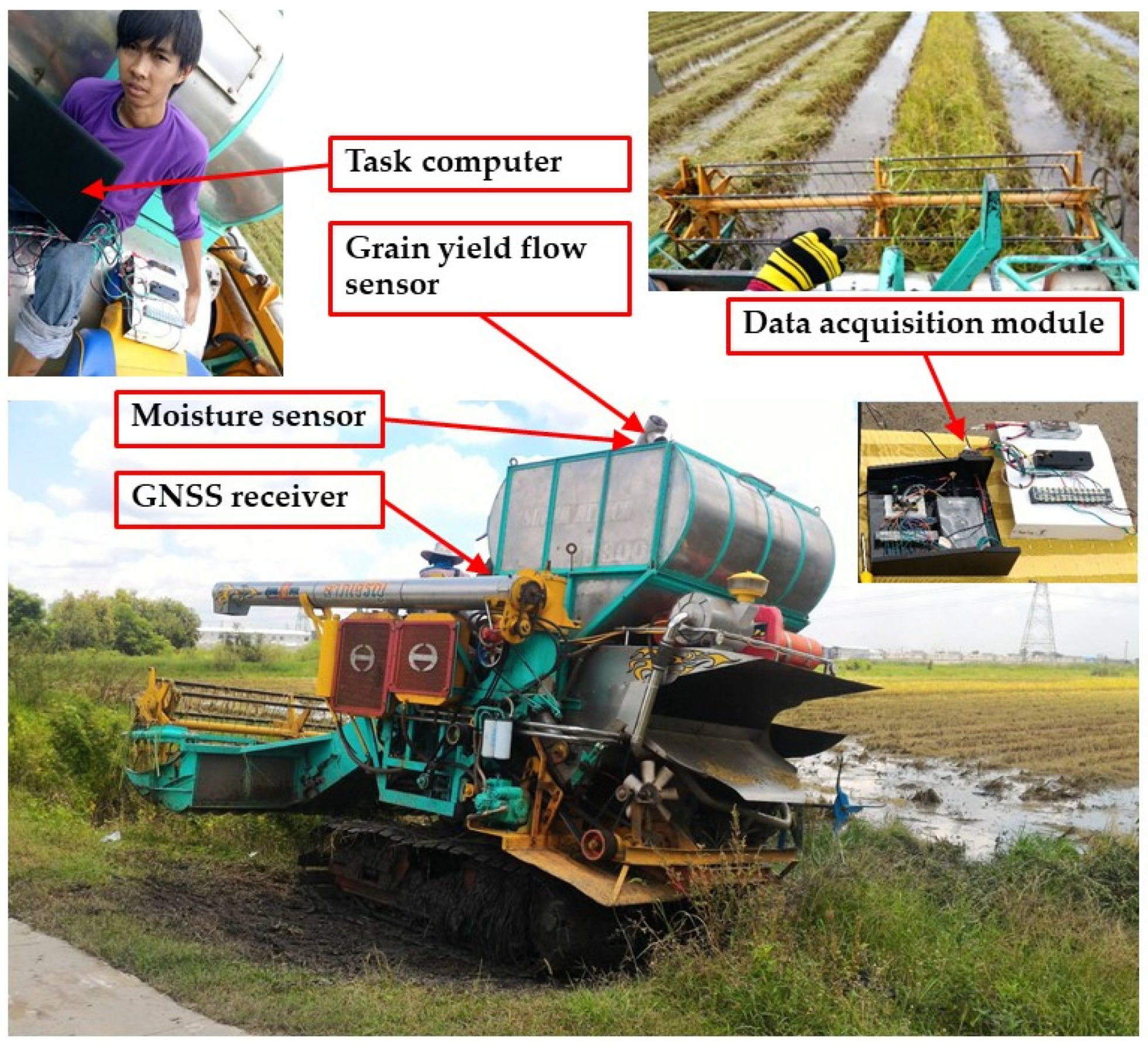
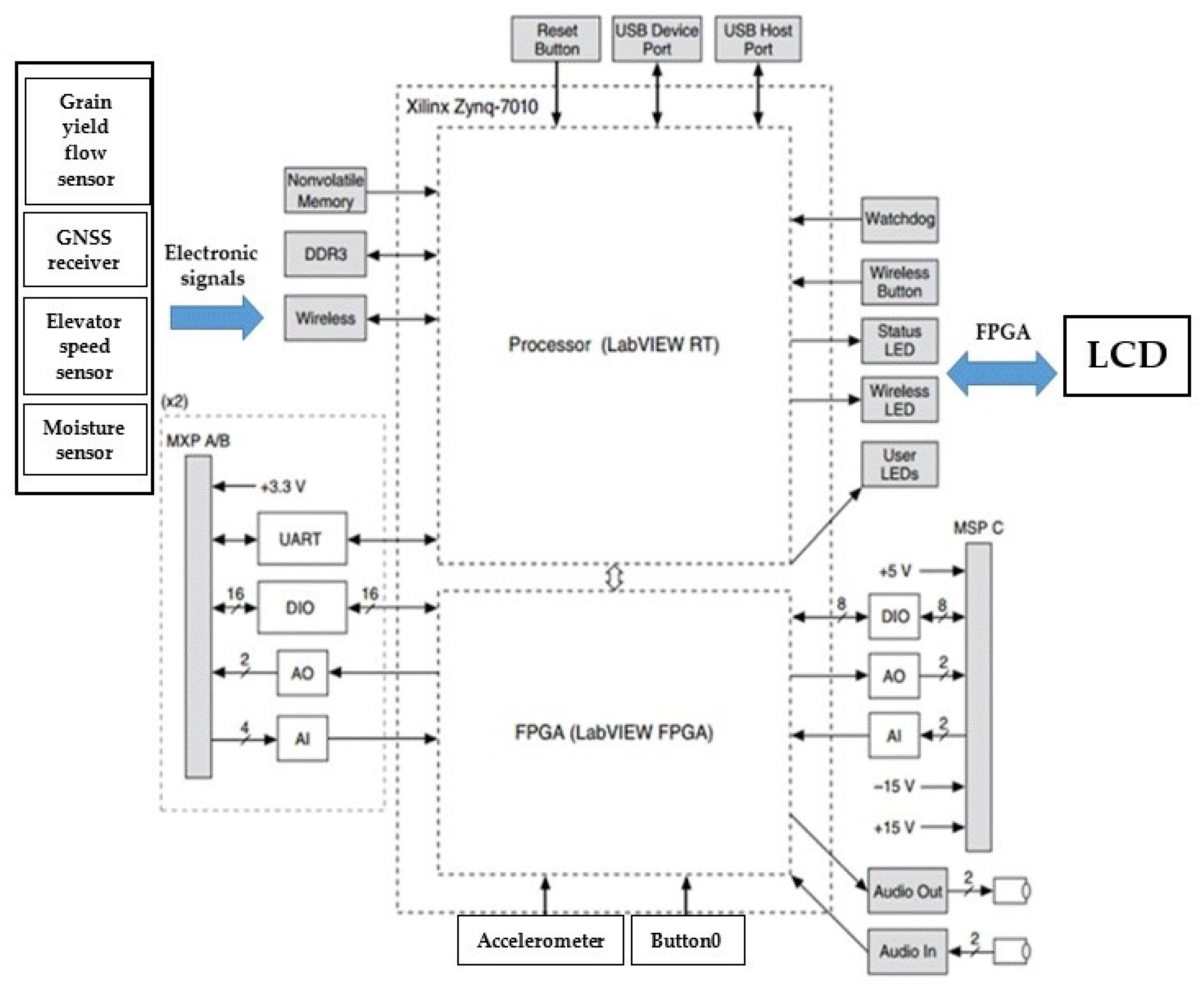
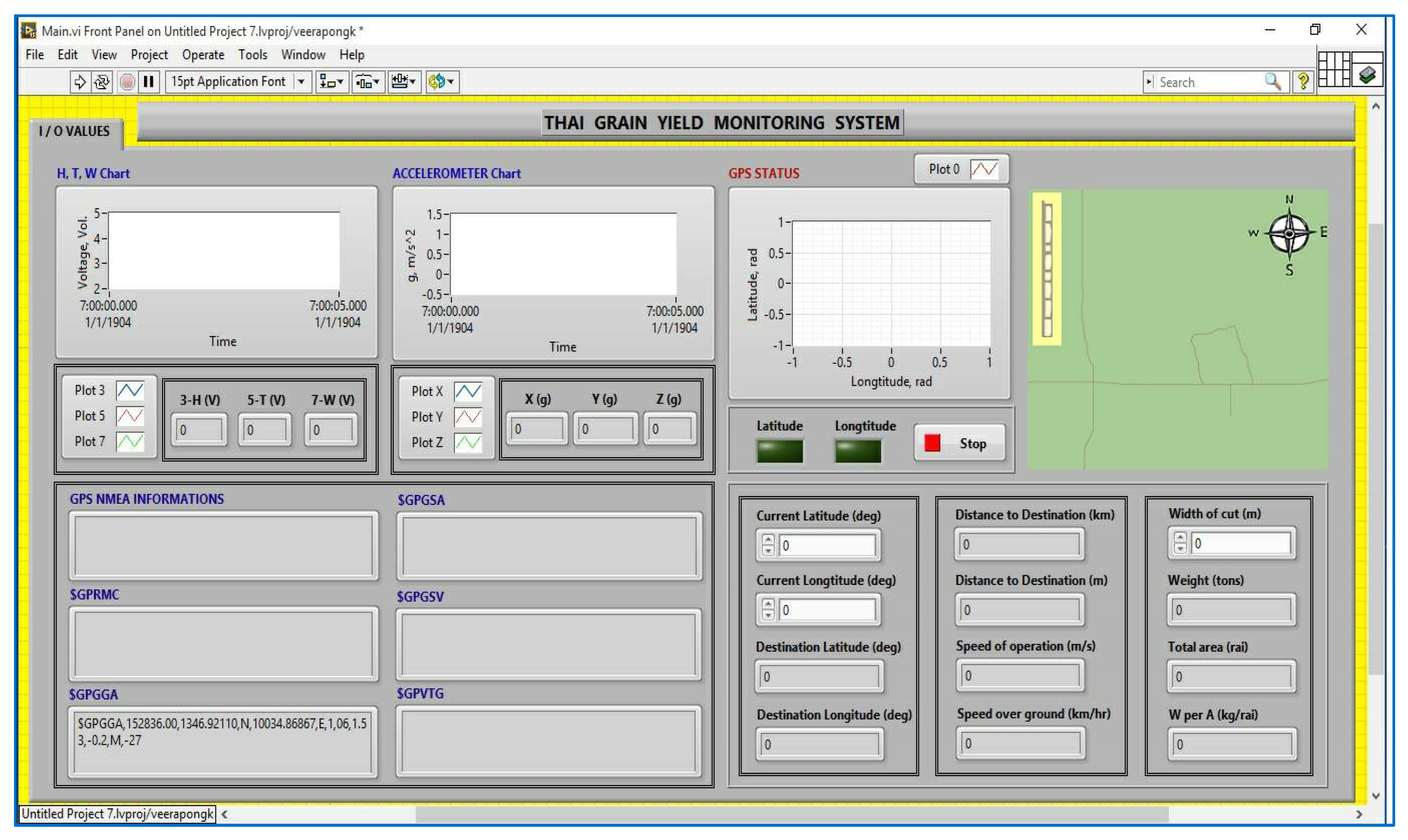
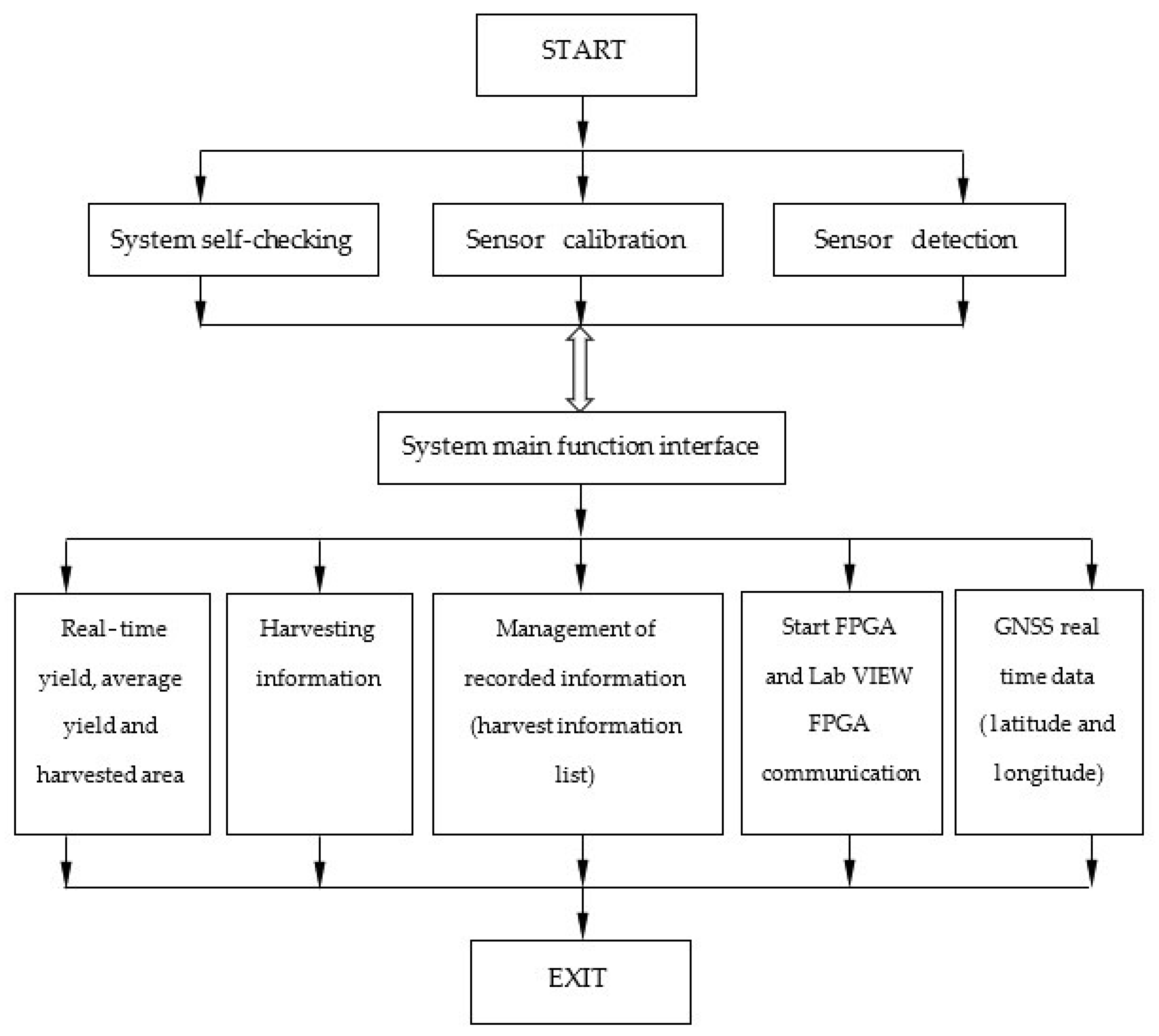
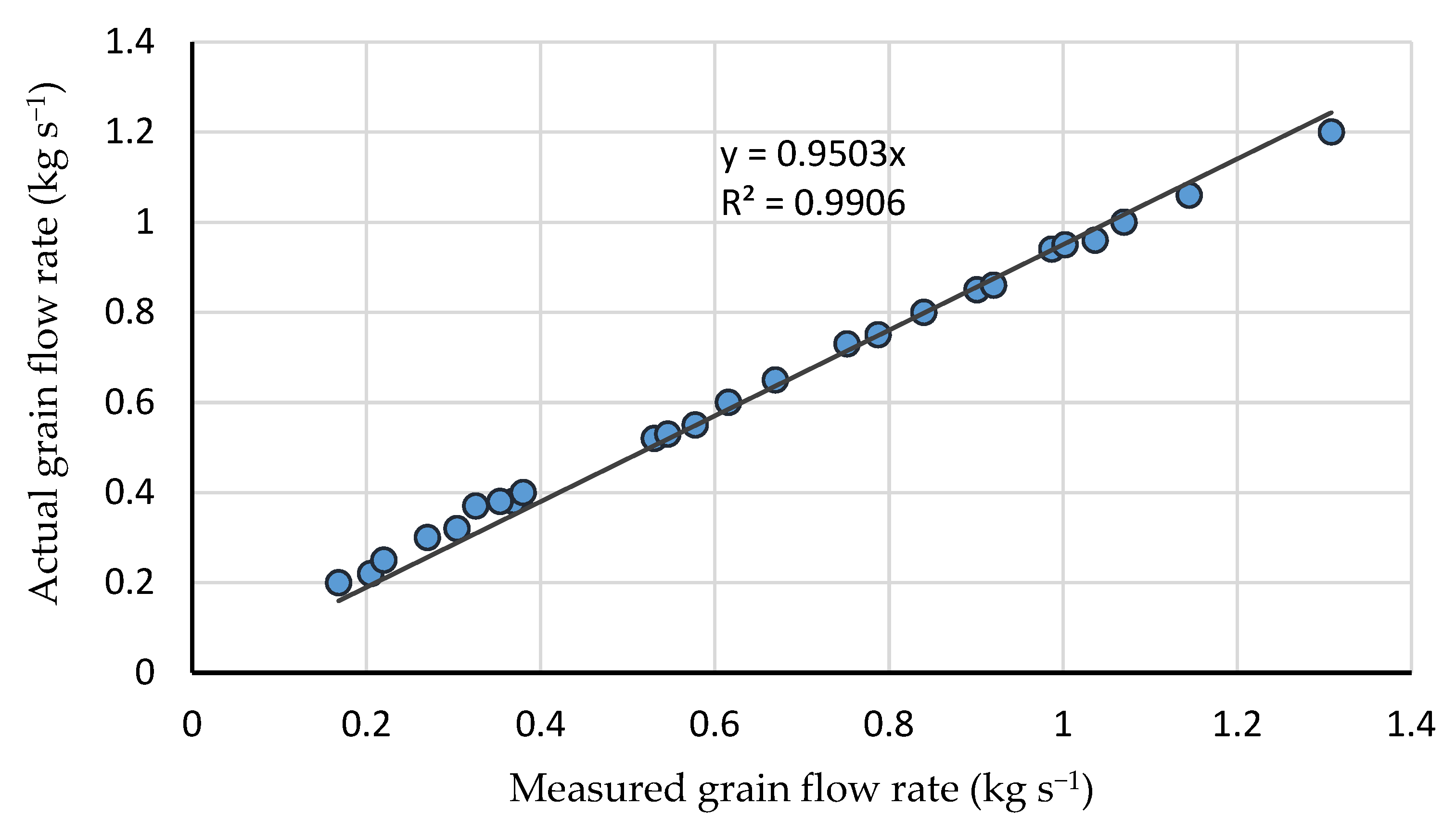
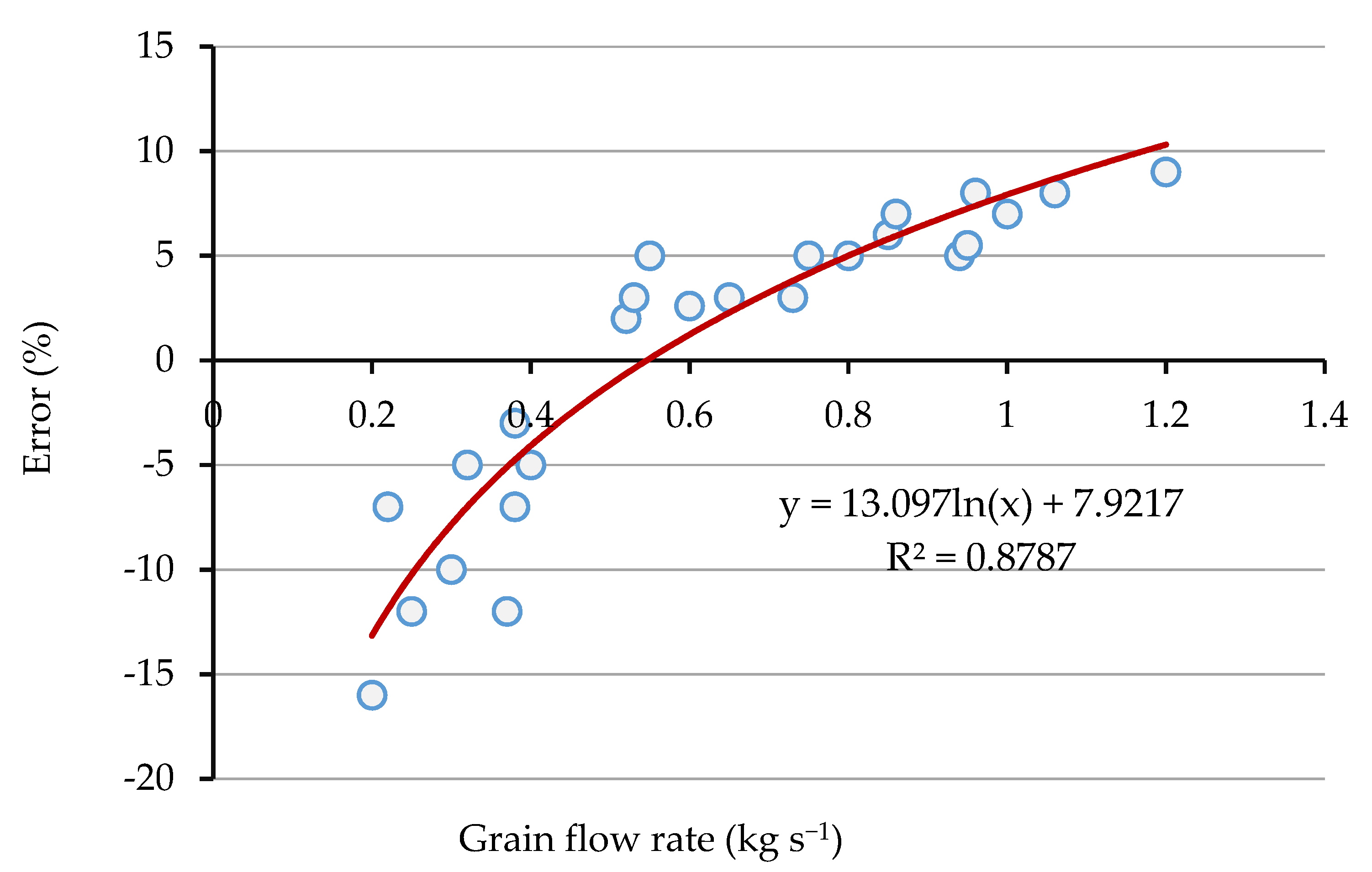

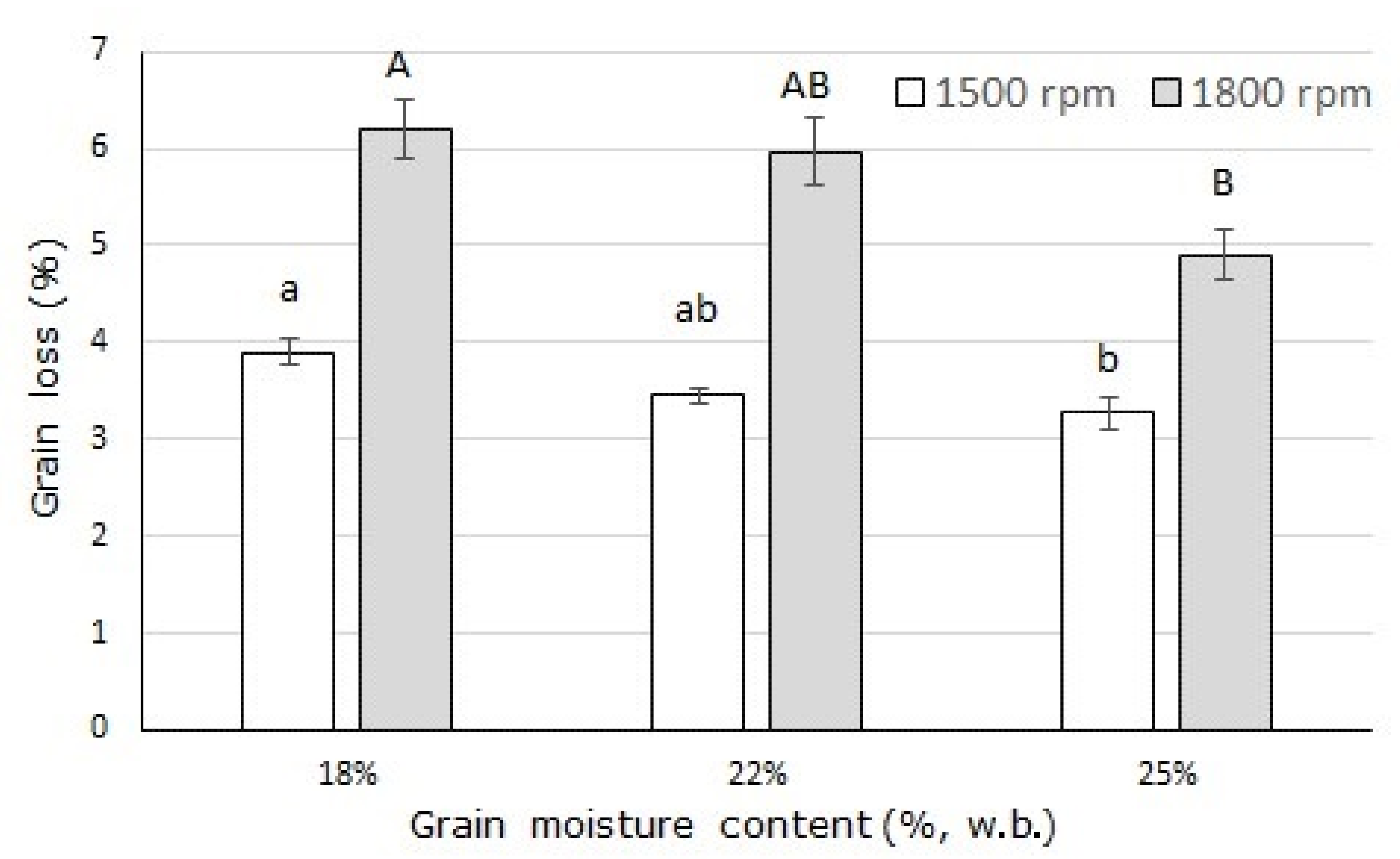

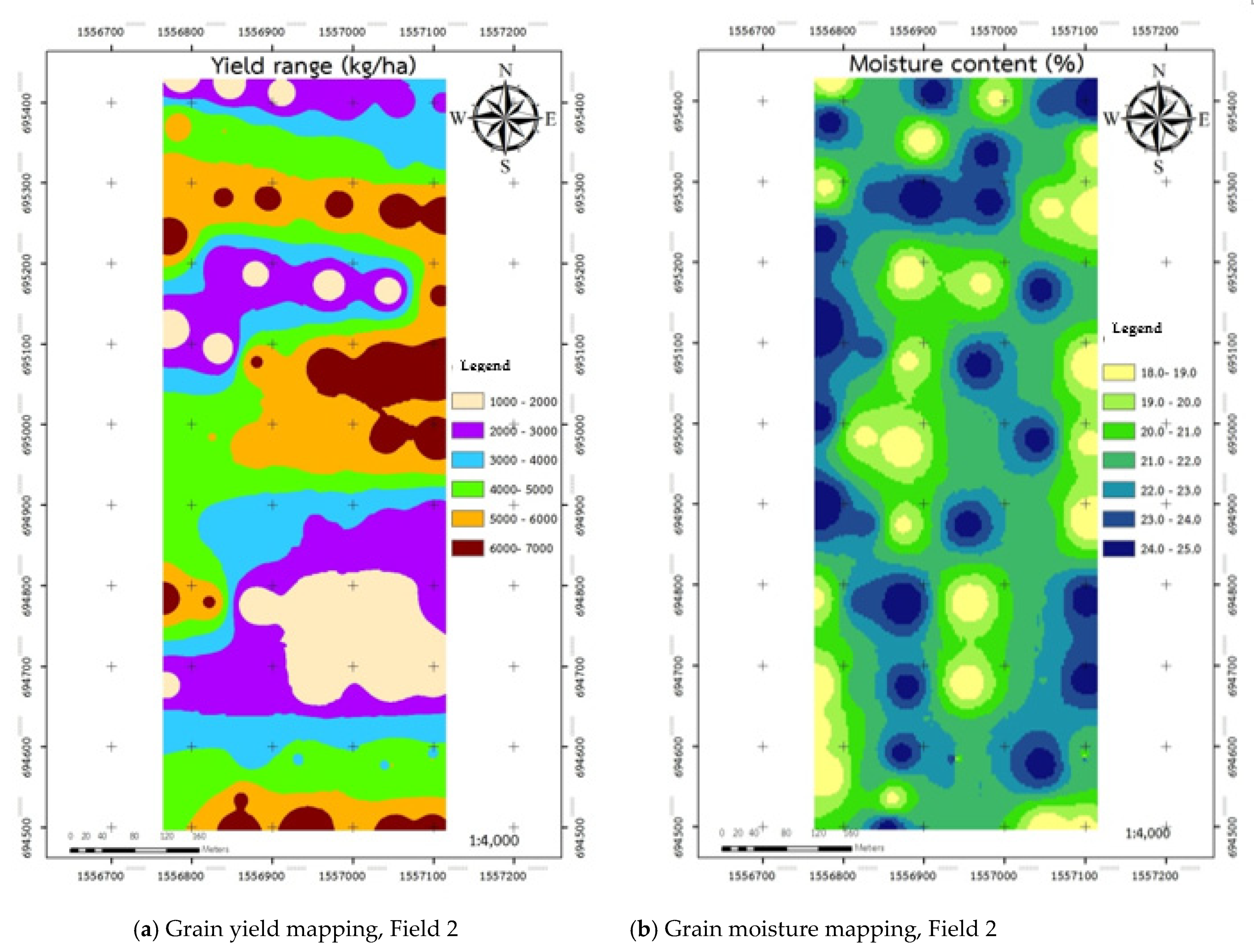
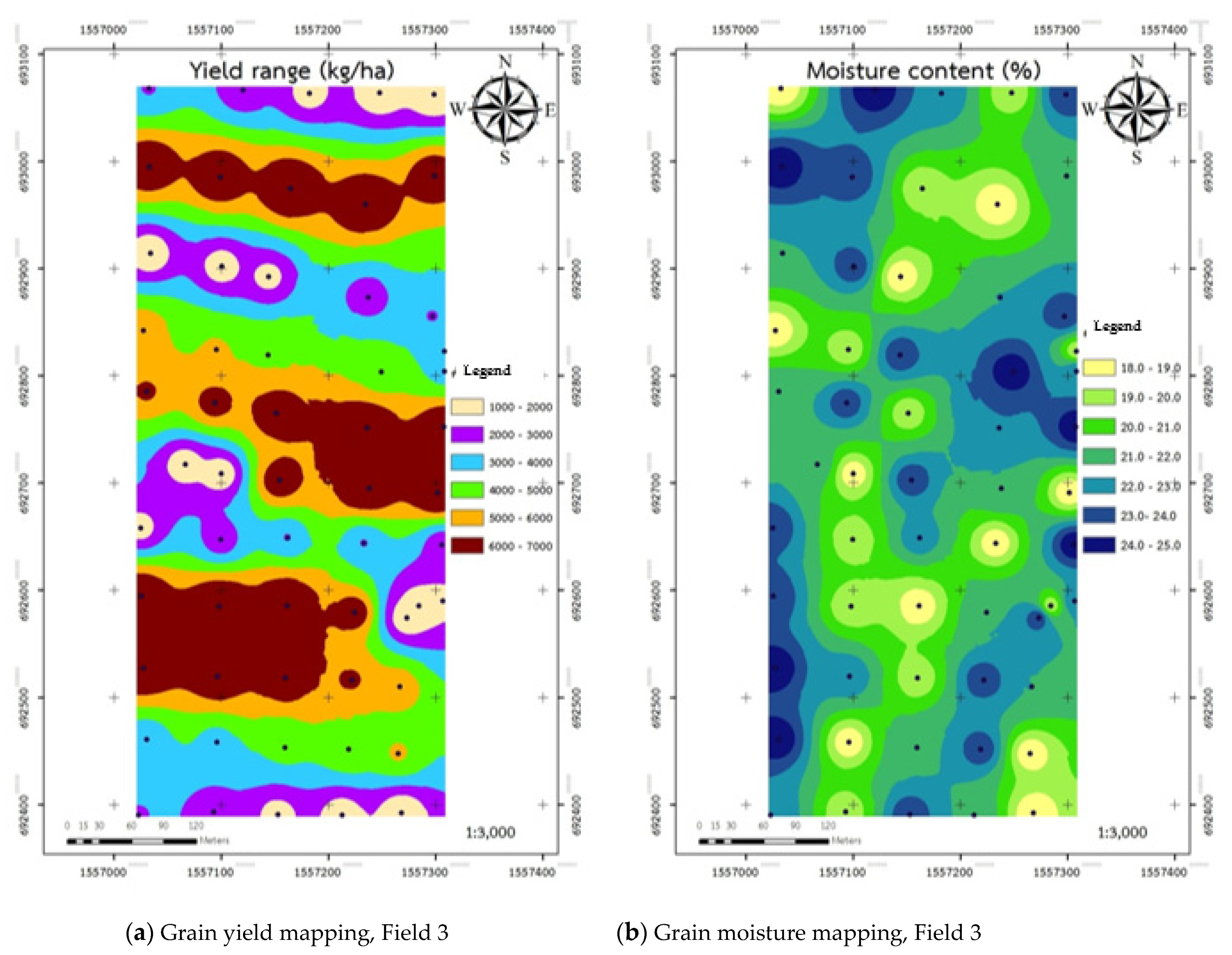
| Feature | Value |
|---|---|
| Thai rice combine harvester | |
| Engine type 1/: | Diesel engine (Nissan RD 28–100 hp) |
| Dimensions (length × breadth × height) 1/: | 4.8 m × 2.1 m × 2.5 m |
| Area under tracked layers 1/: | 2.4 m2 |
| Track size 1/: | 300 × 110 mm2 |
| Total weight without grains 1/: | 2.8 tons |
| Soil compaction under tracked wheel: | 18 kPa |
| Width of cut 1/: | 1.85 m |
| Front auger dimension 1/: | φ 0.33 m × 1.85 m |
| Amount of cut 1/: | 25 pieces |
| Dimension of threshing unit 1/: | 3 feet |
| Spacing of spike tooth pattern for axial flow rice combine harvester 1/: | 1 cm |
| Area of paddy separator 1/: | 0.99 m2 |
| Paddy field details | |
| Rice plant height: | 116 cm |
| Rice straw height: | 18.7 cm |
| Rice plant inclination from vertical: | 5° |
| Total rice yield: | 5 t ha−1 |
| Grain moisture content, %w.b.: | 23% |
| System details | |
| Header loss: | 10.56 kg ha−1 |
| Grain loss at straw spreader: | 11.43 kg ha−1 |
| Total grain loss: | 22 kg ha−1 |
| Forward speed: | 3.4 km h−1 |
| Field efficiency: | 88% |
| Fuel consumption rate: | 18.62 l ha−1 |
| Percent of clean grain: | 95% |
| Custom hiring rate with driver: | 93.75 USD ha−1 |
| Job No. | Yield Auger Assembly | Total Weights (kg) | |||
|---|---|---|---|---|---|
| Average Grain Flow Setting (kg/s) | Angle of Yield Auger (°) | Actual (kg/s) | Yield Sensor Meter (kg/s) | Error (%) | |
| 1 | 0.4 | 15 30 45 | 0.40 0.40 0.41 | 0.333 0.332 0.329 | 16.8 16.9 17.7 |
| 2 | 0.6 | 15 30 45 | 0.60 0.61 0.61 | 0.487 0.486 0.483 | 18.8 19.0 19.5 |
| 3 | 0.8 | 15 30 45 | 0.81 0.81 0.82 | 0.641 0.638 0.635 | 19.8 20.2 20.6 |
| 4 | 1.0 | 15 30 45 | 1.02 1.02 1.03 | 0.789 0.762 0.749 | 21.1 23.8 25.1 |
| Job No. | Average Cutter Bar Height from Ground (m) | Grain Flow Rate (kg s−1) | Error (%) | |
|---|---|---|---|---|
| Actual | Yield Meter Output | |||
| 1 | 0.18 | 0.45 | 0.387 a | 14.00 |
| 2 | 0.25 | 0.52 | 0.411 b | 20.96 |
| 3 | 0.35 | 0.63 | 0.512 c | 18.08 |
| 4 | 0.40 | 0.84 | 0.735 d | 12.50 |
| 0.3 ha | 0.4 ha | 0.5 ha | ||||
|---|---|---|---|---|---|---|
| Area | kg/ha | Area | kg/ha | Area | kg/ha | |
| 0.022 | 1897.6 | 0.024 | 578.1 | 0.025 | 591.1 | |
| 0.031 | 2783.2 | 0.04 | 1809.4 | 0.125 | 6752.6 | |
| 0.265 | 6358.9 | 0.072 | 5742.1 | 0.36 | 7163.2 | |
| 0.27 | 7761.6 | |||||
| Total field area (ha) | 0.318 | 0.406 | 0. 51 | |||
| Average yield (weighted) | 5701.7 | 6392.4 | 6740.4 | |||
| Yield variability within field (SD) | 1928.5 | 2902.2 | 3006.0 | |||
| Average yield (simple) | 3679.9 | 3972.8 | 4835.6 | |||
Publisher’s Note: MDPI stays neutral with regard to jurisdictional claims in published maps and institutional affiliations. |
© 2021 by the authors. Licensee MDPI, Basel, Switzerland. This article is an open access article distributed under the terms and conditions of the Creative Commons Attribution (CC BY) license (https://creativecommons.org/licenses/by/4.0/).
Share and Cite
Sirikun, C.; Samseemoung, G.; Soni, P.; Langkapin, J.; Srinonchat, J. A Grain Yield Sensor for Yield Mapping with Local Rice Combine Harvester. Agriculture 2021, 11, 897. https://doi.org/10.3390/agriculture11090897
Sirikun C, Samseemoung G, Soni P, Langkapin J, Srinonchat J. A Grain Yield Sensor for Yield Mapping with Local Rice Combine Harvester. Agriculture. 2021; 11(9):897. https://doi.org/10.3390/agriculture11090897
Chicago/Turabian StyleSirikun, Chaiyan, Grianggai Samseemoung, Peeyush Soni, Jaturong Langkapin, and Jakkree Srinonchat. 2021. "A Grain Yield Sensor for Yield Mapping with Local Rice Combine Harvester" Agriculture 11, no. 9: 897. https://doi.org/10.3390/agriculture11090897






